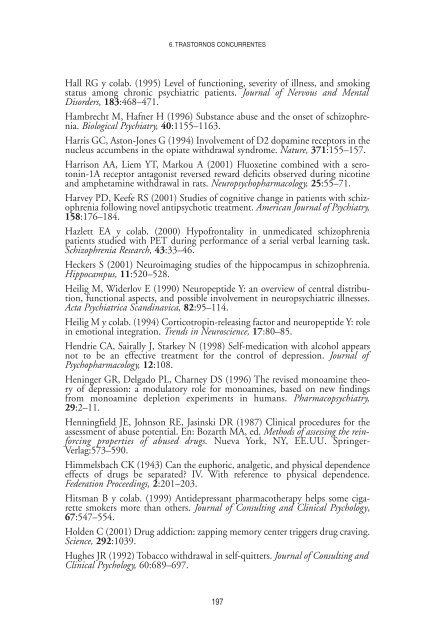Neurociencia del consumo y dependencia de sustancias psicoactivas
Neurociencia del consumo y dependencia de sustancias psicoactivas
Neurociencia del consumo y dependencia de sustancias psicoactivas
You also want an ePaper? Increase the reach of your titles
YUMPU automatically turns print PDFs into web optimized ePapers that Google loves.
6. TRASTORNOS CONCURRENTES<br />
Hall RG y colab. (1995) Level of functioning, severity of illness, and smoking<br />
status among chronic psychiatric patients. Journal of Nervous and Mental<br />
Disor<strong>de</strong>rs, 183:468–471.<br />
Hambrecht M, Hafner H (1996) Substance abuse and the onset of schizophrenia.<br />
Biological Psychiatry, 40:1155–1163.<br />
Harris GC, Aston-Jones G (1994) Involvement of D2 dopamine receptors in the<br />
nucleus accumbens in the opiate withdrawal syndrome. Nature, 371:155–157.<br />
Harrison AA, Liem YT, Markou A (2001) Fluoxetine combined with a serotonin-1A<br />
receptor antagonist reversed reward <strong>de</strong>ficits observed during nicotine<br />
and amphetamine withdrawal in rats. Neuropsychopharmacology, 25:55–71.<br />
Harvey PD, Keefe RS (2001) Studies of cognitive change in patients with schizophrenia<br />
following novel antipsychotic treatment. American Journal of Psychiatry,<br />
158:176–184.<br />
Hazlett EA y colab. (2000) Hypofrontality in unmedicated schizophrenia<br />
patients studied with PET during performance of a serial verbal learning task.<br />
Schizophrenia Research, 43:33–46.<br />
Heckers S (2001) Neuroimaging studies of the hippocampus in schizophrenia.<br />
Hippocampus, 11:520–528.<br />
Heilig M, Wi<strong>de</strong>rlov E (1990) Neuropepti<strong>de</strong> Y: an overview of central distribution,<br />
functional aspects, and possible involvement in neuropsychiatric illnesses.<br />
Acta Psychiatrica Scandinavica, 82:95–114.<br />
Heilig M y colab. (1994) Corticotropin-releasing factor and neuropepti<strong>de</strong> Y: role<br />
in emotional integration. Trends in Neuroscience, 17:80–85.<br />
Hendrie CA, Sairally J, Starkey N (1998) Self-medication with alcohol appears<br />
not to be an effective treatment for the control of <strong>de</strong>pression. Journal of<br />
Psychopharmacology, 12:108.<br />
Heninger GR, Delgado PL, Charney DS (1996) The revised monoamine theory<br />
of <strong>de</strong>pression: a modulatory role for monoamines, based on new findings<br />
from monoamine <strong>de</strong>pletion experiments in humans. Pharmacopsychiatry,<br />
29:2–11.<br />
Henningfield JE, Johnson RE, Jasinski DR (1987) Clinical procedures for the<br />
assessment of abuse potential. En: Bozarth MA, ed. Methods of assessing the reinforcing<br />
properties of abused drugs. Nueva York, NY, EE.UU. Springer-<br />
Verlag:573–590.<br />
Himmelsbach CK (1943) Can the euphoric, analgetic, and physical <strong>de</strong>pen<strong>de</strong>nce<br />
effects of drugs be separated? IV. With reference to physical <strong>de</strong>pen<strong>de</strong>nce.<br />
Fe<strong>de</strong>ration Proceedings, 2:201–203.<br />
Hitsman B y colab. (1999) Anti<strong>de</strong>pressant pharmacotherapy helps some cigarette<br />
smokers more than others. Journal of Consulting and Clinical Psychology,<br />
67:547–554.<br />
Hol<strong>de</strong>n C (2001) Drug addiction: zapping memory center triggers drug craving.<br />
Science, 292:1039.<br />
Hughes JR (1992) Tobacco withdrawal in self-quitters. Journal of Consulting and<br />
Clinical Psychology, 60:689–697.<br />
197

















